Obstacle Avoiding Car
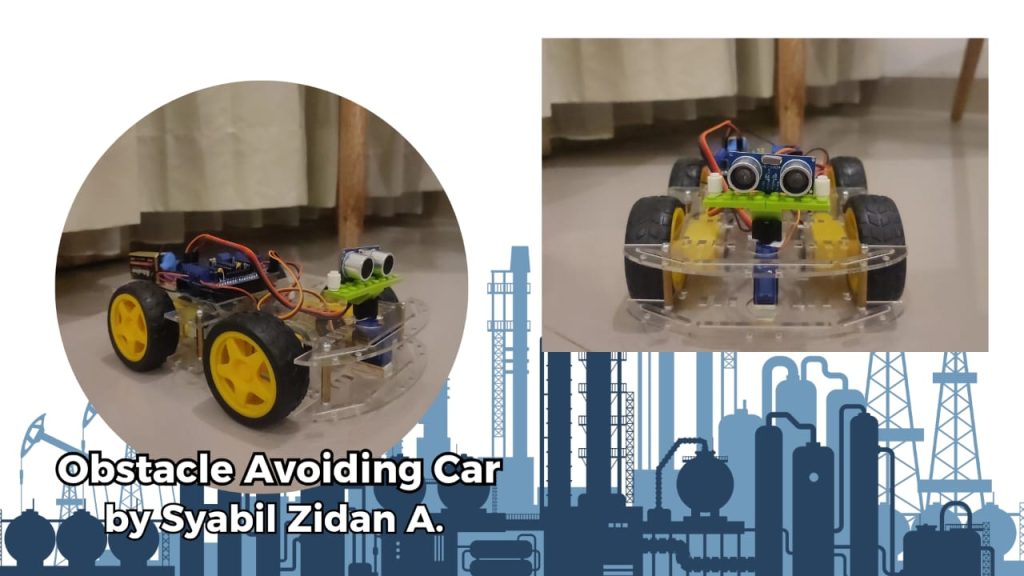
“I’ve built a smart little car that can navigate its way around obstacles all on its own. It’s like having a personal chauffeur, but in miniature form! The car uses sensors to detect any obstacles in its path, and then it automatically steers itself away to avoid a collision. It’s all powered by an Arduino Uno, which is like the car’s brain, and I programmed it using Pictoblox, a visual programming language that makes coding fun and easy. The code itself is written in C++, which is a powerful language that lets me control every aspect of the car’s behavior. From the way it senses obstacles to the way it turns and moves, it’s all thanks to the code I wrote. It was a challenging project, but I learned so much about electronics, programming, and robotics. And now, I have a cool little car that can navigate its way around without bumping into anything. It’s a great feeling to see something I built come to life, and I’m excited to see what other amazing things I can create in the future.”
Ecovate
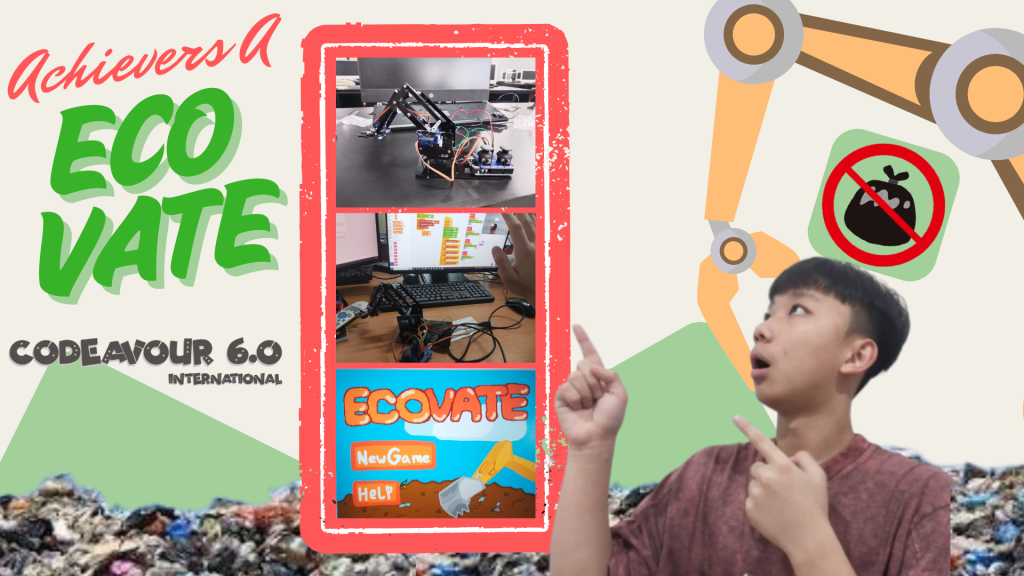
Introducing Ecovate, an innovative excavator robot designed to upgrade waste and trash collection through advanced machine learning and dual-control technology. So, unlike traditional excavators that rely solely on complex manual controls, Ecovate offers both AI-driven hand pose detection and joystick-based operation, providing flexibility and ease of use.
Operators can control the robot remotely using a joystick for precision tasks or switch to AI-powered hand gesture control, which interprets real-time signals for intuitive movement. This dual-system approach allows seamless adaptation to different environments and user preferences. Trained using Pictoblox, our machine learning model ensures accurate hand pose recognition, making waste handling more efficient and responsive.
Ecovate is also built for long-distance operation, enabling users to manage waste collection remotely from a laptop and can be done anywhere without needing for the user to be directly at the work site. This minimizes human exposure to hazardous or unwanted waste and improves workplace and enviroment safety. Additionally, with customizable speed settings and adaptable infrastructure, the robot can function in urban, industrial, and remote areas, making it a versatile solution for waste management.
By integrating AI, robotics, and sustainable automation, Ecovate represents the future of waste collection—reducing manual labor, enhancing efficiency, and contributing to cleaner, safer communities worldwid
Safe From Shock
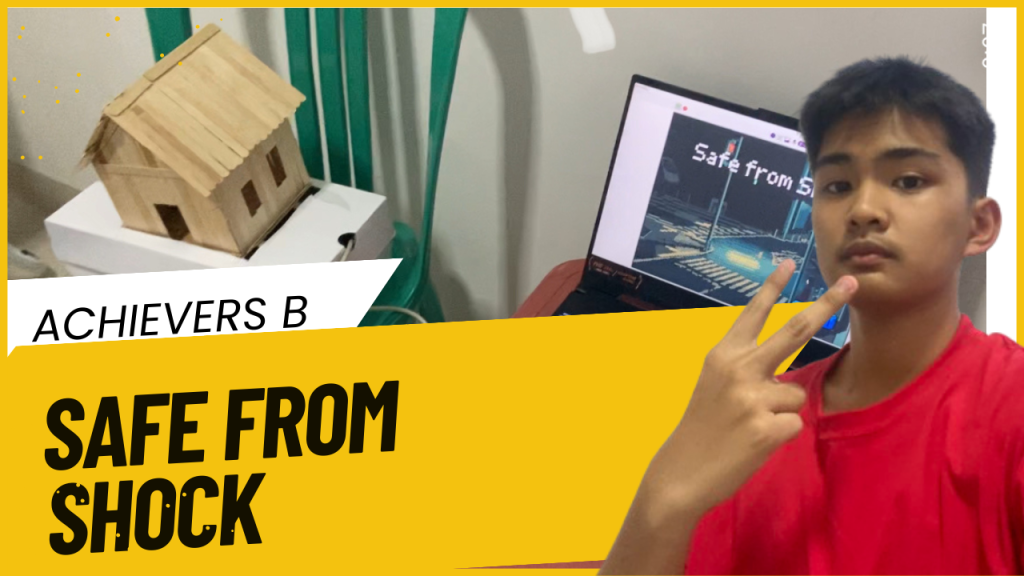
Every year, earthquakes claim the lives of approximately 60,000 people, frequently as a result of inadequate preparation. Traditional drills are effective at training big groups, but they can come across as monotonous and uninteresting. Using PictoBlox and Arduino, we created an AI-powered earthquake simulator to improve earthquake education, producing a realistic and engaging learning environment.
AI is used in this simulator to identify player motions and make sure they react appropriately in the event of an earthquake. The experience is made more realistic and engaging by simulating earthquakes with a little model equipped with servo motors. Users must actively respond to the simulation, strengthening their comprehension through real-time testing and feedback, as opposed to passively learning safety protocols. Additionally, it enables customizable scenarios, which increases readiness for a range of earthquake intensities by adapting training to diverse environments and skill levels.
Even though it might not be as effective as conventional drills at training big groups of people at once, it provides more individualized learning and deeper engagement, guaranteeing that users actually retain replies that could save lives. This project creates a connection between technology and disaster preparedness by fusing physical seismic effects with AI-driven interactivity, offering a creative and useful teaching tool. Through interactive learning and training experiences that are adaptable for all age groups, this simulator can greatly increase earthquake preparation when used in conjunction with traditional exercises, potentially saving more lives.
P.O.C
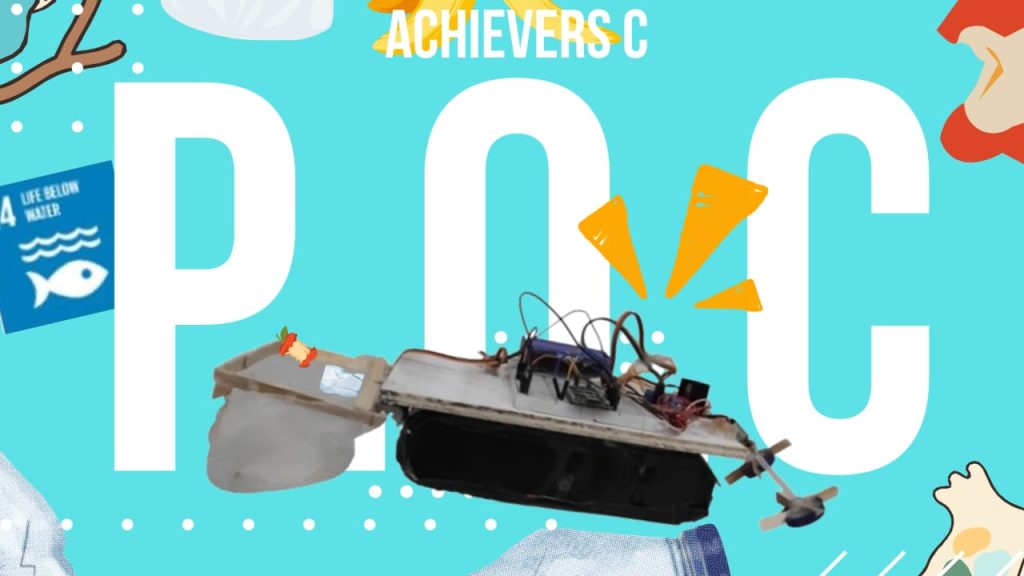
Meet P.O.C, Pocket Ocean Cleaner. P.O.C ensure healthy ocean wildlife across the ocean. P.O.C is specially made to take trash, Big and Small in any body of water. P.O.C can move and take trash Wirelessly with Bluetooth up to 5m long. P.O.C is easy to setup, and easy to create. P.O.C helps people around the world, and any age to take part on cleaning our oceans for a better future. P.O.C is made to change life below water by cleaning trash that could be eaten, stuck, or drop on. Even if we help 1%, it could change everything. P.O.C consist of:
– 1 L298N Motor driver
– 2 Motors
– ESP32
– SG90 Servo
– 3 Lithium-ion batteries
– 1 Kamera
What if you dont have a P.O.C? Well lucky for you, since we made Game called “Wipe The Waves”. Some might ask, What is this game about? This game is a simulation of how P.O.C will work but also teaches kids and adults about Sustaining ocean life and spread awareness about trash in the Ocean. This game is easy to play for all ages and can be played by using a laptop to give easy access for all people to play, no matter the place, no matter the region. P.O.C, Take part in saving Ocean life no matter the plac
LiteHouse
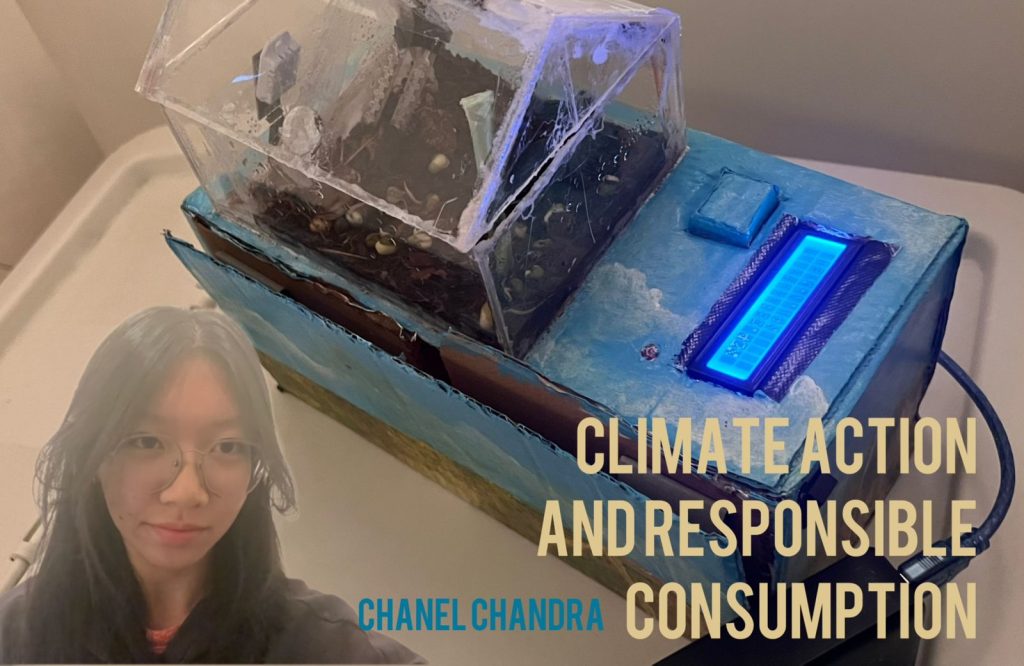
LiteHouse is an innovative, self-sustaining plant system designed to tackle food insecurity in urban areas, where land for farming is becoming increasingly scarce due to rapid population growth. Built within an acrylic house structure that acts as the pot itself, LiteHouse allows people to grow food in small spaces by integrating automation, smart sensors, and efficient energy use to maintain an ideal environment for plant growth.
One of LiteHouse’s key innovations is its automated watering system, which uses a moisture soil sensor to detect dryness. When the soil becomes too dry, a DC water pump and motor activate a sprinkler system to provide the necessary water. In addition to water control, LiteHouse also manages light and climate conditions. A DHT22 sensor tracks temperature and humidity, while a light sensor measures light exposure. An RGB LED indicates light levels by changing color, and UV lights automatically turn on every six hours to support plant nutrition when necessary.
To ensure efficiency,iteHouse uses a Real-Time Clock (RTC), allowing it to make time-based decisions, such as checking soil moisture every three hours or adjusting light exposure. Users can manually activate the sprinkler using an IR sensor button, while an LCD display provides real-time updates on temperature, humidity, and watering status. The system is powered by a rechargeable power bank for the Arduino and a 9V battery for the pump and motor, making it energy-efficient and adaptable to different urban settings.
Designed with tauge (bean sprouts) as an example, LiteHouse provides a sustainable and accessible way for urban residents to grow their own food, reducing reliance on store-bought produce and minimizing food waste. By integrating technology with urban farming, LiteHouse promotes responsible consumption, sustainable food production, and climate-conscious living, making it a practical solution for the future of urban agriculture
Detext: Real-Time Speech Recognition for the Deaf
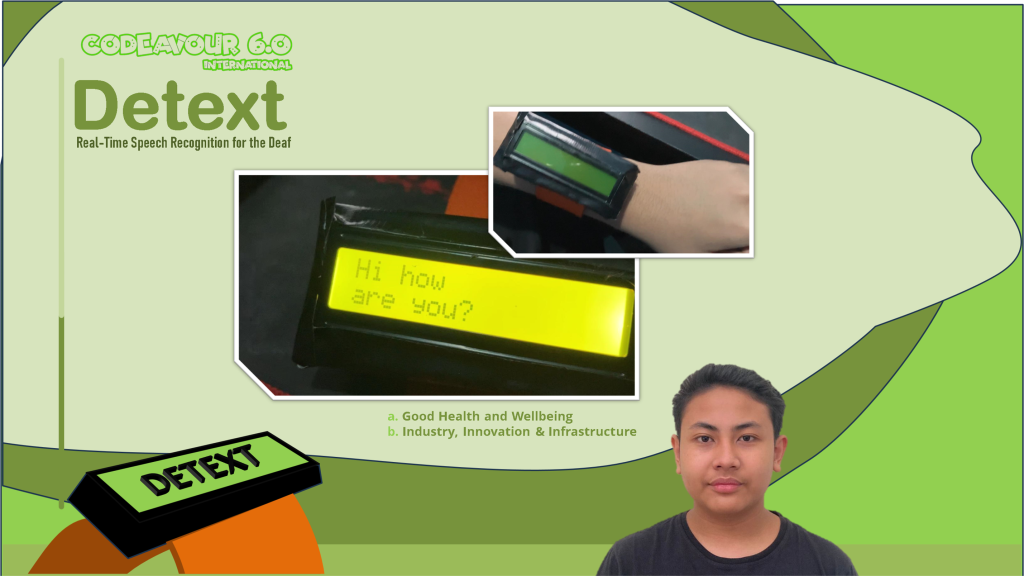
Detext is an innovative, wearable device designed to assist deaf and hard-of-hearing individuals in real-time conversations. Built as a bracelet with a 16×2 LCD display and powered by an Arduino Nano, Detext provides an affordable and compact solution for overcoming communication barriers in public interactions.
Unlike traditional speech-to-text apps that require smartphones and manual operation, Detext offers a hands-free experience, allowing users to receive live transcriptions directly on their wrist. One of its key features is the intelligent punctuation system—it automatically adds question marks at the end of sentences containin”what, when, who, where, and how” since many speech recognition systems struggle to detect questions accurately.
Designed with accessibility and affordability in mind, Detext is a budget-friendly alternative to existing assistive technologies, making it more accessible to individuals with financial constraints. Its lightweight and ergonomic design ensures ease of use and comfort, while its low power consumption enhances battery efficiency (future versions may include battery integration).
While still in the prototype stage, Detext has the potential to evolve further with enhancements such as wireless connectivity, improved display options, and multi-language support. With its simplicity, effectiveness, and affordability, Detext aims to empower the deaf community by making everyday conversations more seamless and inclusive.
EcoIrrigate
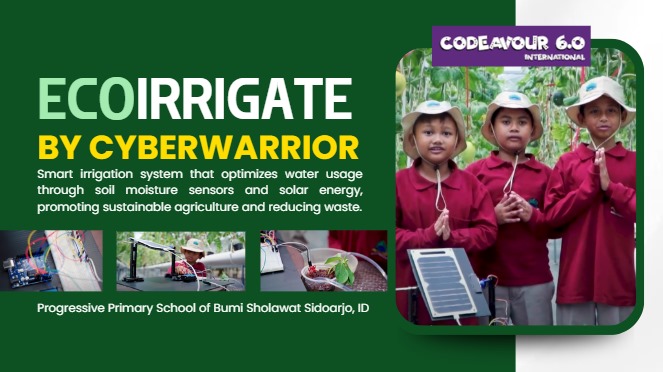
The Arduino-based Smart Automatic Irrigation System with Solar Tracking is an innovative irrigation solution that integrates solar panel technology with plant watering systems. This system is specifically designed to enhance the efficiency of water and energy usage in agricultural irrigation processes.
The system’s main components include an Arduino microcontroller, which serves as the central control unit, a soil moisture sensor for monitoring soil conditions, a water pump for irrigation, solar panels for power generation, and a solar tracker system. The automation principle is straightforward: the water pump is activated when the soil moisture sensor detects that the soil’s moisture level has fallen below a predetermined threshold.
A key feature of this system is its solar tracking capability, which employs two LDR (Light Dependent Resistor) sensors. These sensors enable the solar panel to follow the sun’s direction throughout the day, thereby maximizing energy absorption. The energy harnessed by the solar panels is stored in lithium batteries connected in series, and a battery management system ensures that this energy is used sustainably.
This system offers several advantages. It promotes water efficiency through sensor-based automatic irrigation, optimizes solar energy absorption via the tracking system, and utilizes environmentally friendly renewable energy. The implementation of this system is particularly suitable for small to medium-scale agricultural operations that require a self-sustaining and sustainable irrigation solution.
The 3 in 1 Tree
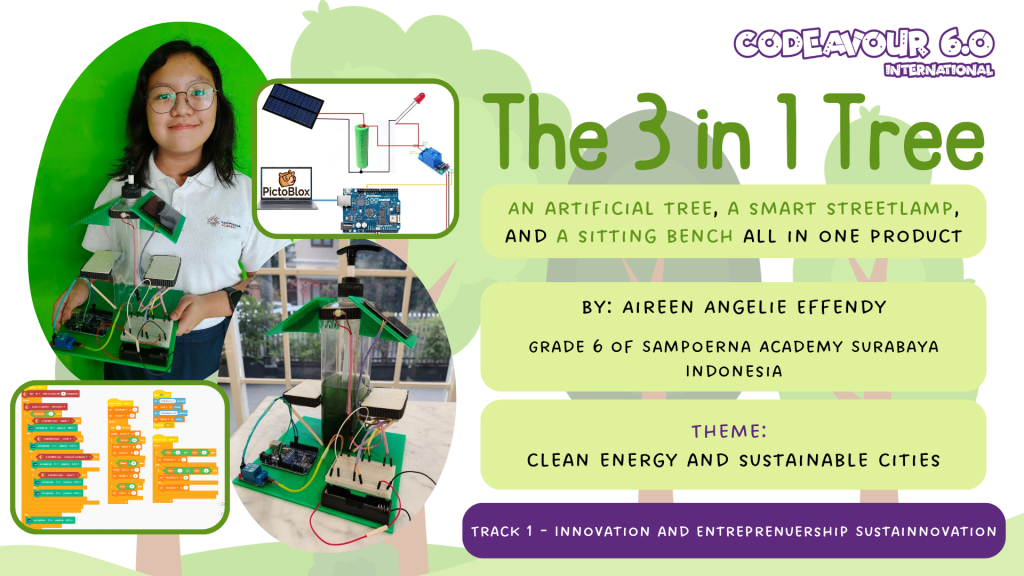
*Description*
The 3 in 1 Tree is an artificial tree, a smart streetlamp, and a sitting bench all in one product.
I used microalgae to clean air pollutants just like real trees, and I also used solar energy, artificial intelligence, and coding for the LED lights to be smart streetlamps.
Microalgae produces half of the oxygen in the world and is about 50 times more efficient than normal trees. It’s also a liquid, so it saves more space since it can fit in one container, and can be placed in urban pockets in a big city. It doesn’t take much time to grow, so it can help us address global challenges because of the rapid air-pollution rising in big cities.
The Solar Panel charges the battery that turns on the LED lights to be more eco-friendly.
There is a Relay as a switch connected between LED and Battery controlled by Arduino which has been programmed in Pictoblox using Machine Learning.
Using a Webcam, it can see whether there’re people, vehicles, animals, or nothing on the street.
The LED lights soff during the day, turn on at night when there are people or vehicles, and stay off at night if only animals or nothing is around.
This makes the 3 in 1 Tree smarter and saves more energy.
I hope this innovation can bring sustainable solutions for a better future in modern society.
HydroRenew: Sewage Treatment System
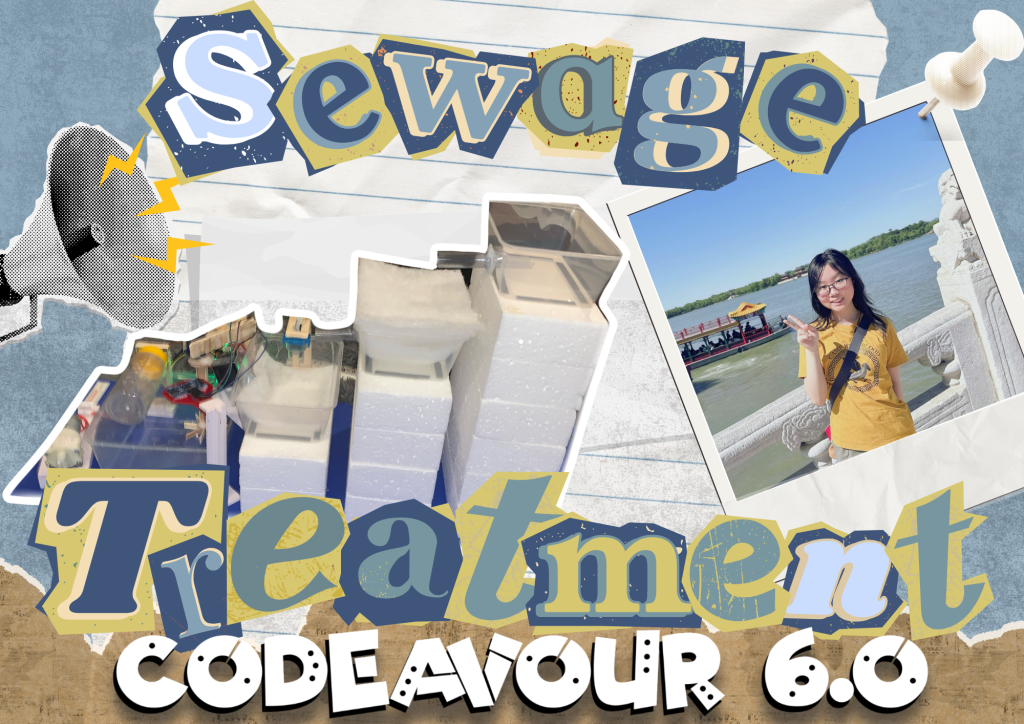
This project addresses flooding, groundwater depletion, and water pollution in cities like Jakarta. It removes pollutants from wastewater by using carbon and filters. The water is made safe through chlorination, which is managed by an Arduino system that uses real-time pH sensor data to control the chlorine release.
Using PictoBlox, the system is automated with AI and Machine Learning (ML) to maximize resource usage and water quality. After being purified, the water is then transferred to recharge pits to replace groundwater: providing a solution to sinking cities and countries.
This system, which intends to addresses water scarcity while lowering urban flooding and encouraging sustainability, is designed with the idea to be useful, effective, and environmentally beneficial for large cities and even smaller communities.
GreenSorting
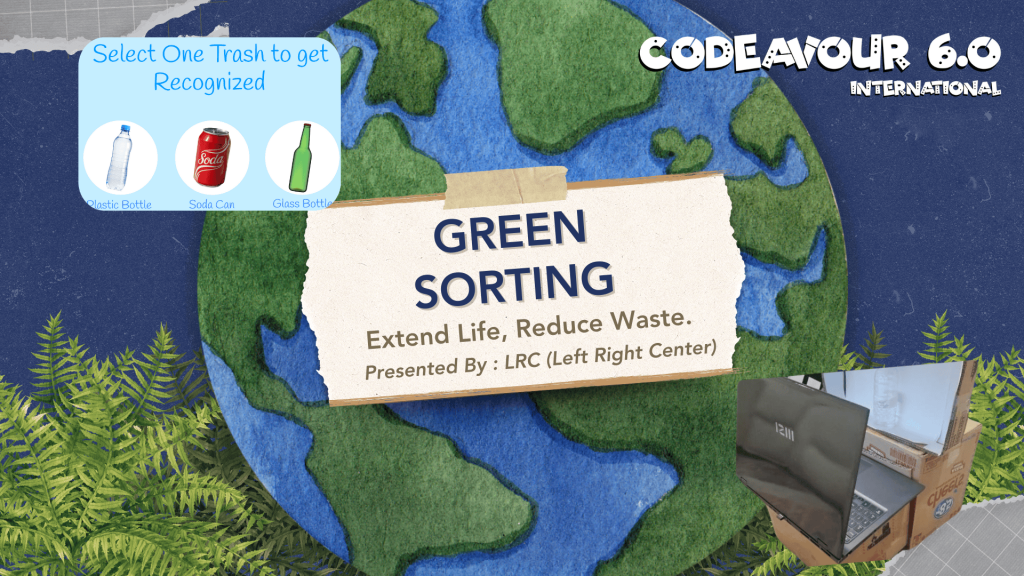
GreenSorting is an innovative online recycling exchange marketplace designed to promote the core ideology of “Reusing and Reducing waste.” The platform connects users who wish to trade recyclable items, ensuring that valuable materials like plastics, furniture, and other resources do not end up unnecessarily discarded in landfills. Instead of throwing these items away, GreenSorting provides an accessible solution where users can share and exchange materials that others can put to good use.
What makes GreenSorting stand out is its unique rewarding system. Users are encouraged to sort and trade recyclable materials in exchange for money, offering a practical incentive to engage in sustainable practices. For example, the earnings can help students pay for school-related expenses, turning waste management into a beneficial opportunity for individuals and families.
GreenSorting simplifies recycling, making it not only an environmentally conscious choice but also a meaningful way to contribute to communities.creating a platform that empowers users to connect and make an impact, GreenSorting ensures that waste is minimized while promoting a culture of sustainability.
Through GreenSorting, we envision a world where recycling is not only a responsibility but also a rewarding experience, helping communities thrive while reducing environmental harm. Together, we can build a greener and more sustainable future.
